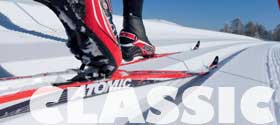Cross-country Classic skiing encompasses several skiing styles, from touring or racing on groomed ski tracks to gliding through deep snow in the back-country. The one common characteristic is that the heel is always “free” (not connected to the ski).
Cross-Country Classic Skis
At Kelowna Cycle Nordic we have a large selection of classic ski’s to choose from, and we are here to help you in making the correct decision on which skis best suit your needs and abilities. Ski lengths have gradually been getting shorter thanks to new technology and design. For some skis you may still be able to select the right length by simply raising your arm and measuring to your wrist. But, in most cases, body weight is now the main determining factor. Unsure of the correct length for you? Keep in mind that shorter skis are slower but easier to handle for recreational skiers or those skiing in rugged terrain. Go shorter if you’re less experienced or go longer if you’re very athletic or if you intend to progress quickly. The Camber and flex are even more important with classic skis. Cross-country skis have a Nordic (or double) camber with 2 parts:
1) When you have equal weight on both skis—as when gliding—the waist or “grip zone” of the ski (the middle third that has either a textured pattern or wax for traction) remains arched up off the snow to ensure an easy glide.
2) When you place all your weight on one ski, you completely flatten that ski against the snow, so that the kick zone grips the snow and gives you traction for your kick forward. This is why your body weight is so important in determining your correct length of ski.
Waxable vs. Waxless Bases
Skis need to grip the snow when you climb on hills or stride on flat terrain (“kick and glide”). Skis achieve grip in 1 of 2 ways: either the bottom of the ski has a manufactured texture pattern or wax is applied.
Waxless skis are the most popular choice because they are convenient and provide grip in a variety of snow conditions. Their textured pattern digs into and grips the snow, though it reduces glide somewhat. Despite their name, waxless skis perform better with some glide wax applied to the tips and tails.
Waxable skis require a bit more work, but they can outperform waxless models if their wax is precisely matched to snow conditions. The wax must be soft enough for snow crystals to dig in and grip, but not so soft that snow sticks to skis. In consistent temperatures above or below freezing, well-waxed skis perform superbly. When temperatures are erratic or right at the freezing point, waxing is difficult and waxless skis are the better choice.
Cross-Country Ski Boots
Fit is always the key to successful ski boot buying. Wear a pair of wool or synthetic ski socks when trying on boots. A good fit is achieved when boots are comfortable and hold your feet solidly in place.
Classic boots offer flexibility for striding along with torsional rigidity for turning and stopping. Boots for metal-edge touring skis are stiffer but are higher-cut, warmer and more durable than general boots. Some will have a plastic “exo-skeleton” for extra rigidity. Once you’ve found the right boots, you can select compatible bindings.
Cross-Country Ski Poles
Traditionally, pole length has been “up to your armpits.” Today, in-track poles can be slightly longer and off-track poles slightly shorter.
Cross-Country Ski Packages
We have many other ski packages that we can tailor to your specific cross country ski needs. We can work with you to build a package that is appropriate for your ski season and budget.

